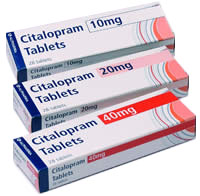What is Citalopram?
Citalopram, which has the common trade name of Celexa in the US, is an FDA approved antidepressant medication that is also often used to treat other mental illnesses, such as anxiety disorders. It maybe also found under the brand name Cipramil in other parts of the world.
This generic drug is part of the selective serotonin reuptake inhibitor (SSRI) class, which diminishes symptoms of depression by blocking the serotonin neurotransmitter from re-entering into the brain. This serotonin process usually works normally and most people do not need this boost, but individuals with major depression disorder will often need it to boost their moods.
Serotonin is a known neurotransmitter that is involved in human emotions. Meaning, an individual’s mood buoys up when there is sufficient and balanced amount of serotonin in the brain. However, like all chemical substances that partially undergo re-absorption process inside the body, when serotonin is reabsorbed its natural effects diminish. Re-absorption would also cause the body to limit production of serotonin. Thus, resulting to major depression or sometimes psychological imbalances, clinically explained as a result of decrease in serotonin production and efficiency.
 Like many anti-depressants, Citalopram may take a few weeks to enter the patients system; therefore relief of symptoms may not be seen immediately.
Like many anti-depressants, Citalopram may take a few weeks to enter the patients system; therefore relief of symptoms may not be seen immediately.
Citalopram Uses
While Citalopram is approved by the FDA to treat major depression (or clinical depression) symptoms, it is also very commonly used to treat anxiety disorders.
- Depression. As mentioned and explained earlier, SSRIs are the drugs of choice for depression. Prozac®, generically known as fluoxetine is the prototype of this drug classification. However, to minimize potent drug interactions especially in older patients, citalopram is used as an alternative since it has fewer drug reactions and side effects.
- Anxiety disorders. The most common type of anxiety disorders managed and treated with citalopram are Obsessive Compulsive Disorder (OCD), panic disorder, social anxiety disorder and Generalized Anxiety Disorder (GAD). Post Traumatic Stress Disorder (PTSD) is also treated with citalopram.
- Other treatments of Citalopram are for alcoholism, autism, dementia, diabetic neuropathy, diabetic neuropathy, eating disorders (including anorexia and bulimia), fibromyalgia, hot flashes, obesity, personality disorders, premature and Tourette’s syndrome.
Adverse Drug Reactions
The most common side effects of citalopram are due to increased serotonergic activity in the body that mostly manifests during the first week of treatment. Following this, other common side effects are nausea, diarrhea, gastric irritation, dizziness, insomnia, headache, tremors and weight gain.
In 30- 40% of patients, sexual effects such as loss of libido, deferred orgasm and decrease arousal are observed. These are correlated to the increased serotonergic activity in the spinal region. In rare occasions, hallucinations, convulsion and allergic reactions may occur.
Drug Preparations, Dosages and Dosing Regimens
All antidepressants are prescription drugs. Meaning, one may only avail of this drug once a prescription from a licensed physician is issued. It is prescribed in either 10, 20 or 40 mg film-coated tablets or 10mg per 5mL oral solution.
Citalopram tablets are taken once a day with or without food while citalopram solution is mixed with water or juice. Keep in mind that going beyond your physician’s orders would result to toxicity. Always follow the dosing regimen prescribed by your physician. Abrupt discontinuation of the drug would result to undesirable withdrawal symptoms. Thus, it is recommended that it should be discontinued slowly in decreasing doses.

